Analyzing Teys Australia's Internalization Drivers & Global Strategy
VerifiedAdded on 2023/06/11
|6
|990
|376
Essay
AI Summary
This essay examines Teys Australia's global strategy, focusing on the drivers of internalization such as market, cost, government, and competitive factors. It analyzes the global strategy options available to Teys, including export, multi-domestic, global, and transnational strategies, recommending a global strategy for enhanced sales and customer satisfaction. The essay also discusses the risks and rewards associated with global strategies, highlighting benefits like increased economies of scale and potential product lifecycle extensions, while also acknowledging macro environment and operational risks. The analysis concludes that a well-executed global strategy, leveraging key drivers, is crucial for the company's business success and growth. Desklib offers a wide range of similar solved assignments and resources for students.
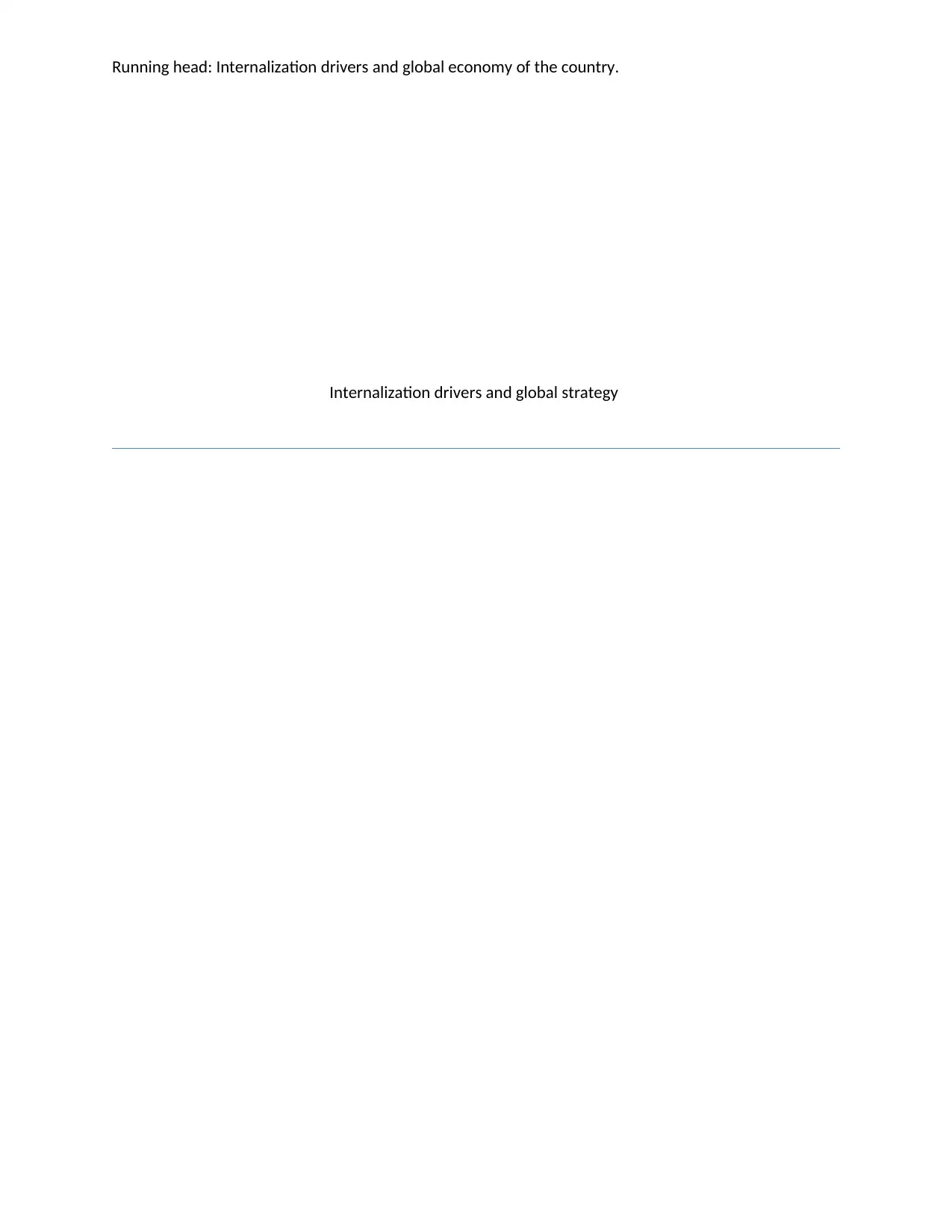
Running head: Internalization drivers and global economy of the country.
Internalization drivers and global strategy
Internalization drivers and global strategy
Paraphrase This Document
Need a fresh take? Get an instant paraphrase of this document with our AI Paraphraser
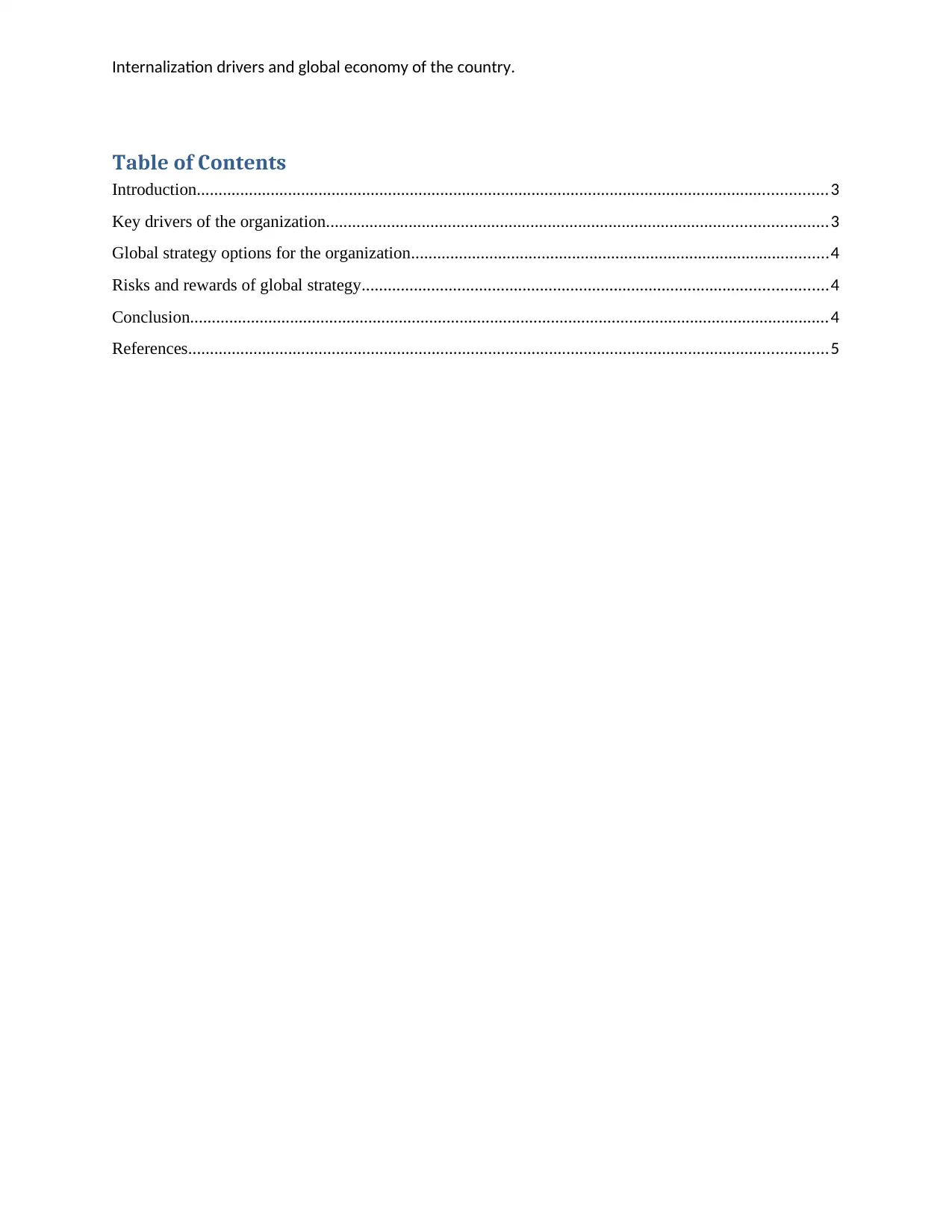
Internalization drivers and global economy of the country.
Table of Contents
Introduction.................................................................................................................................................3
Key drivers of the organization...................................................................................................................3
Global strategy options for the organization................................................................................................4
Risks and rewards of global strategy...........................................................................................................4
Conclusion...................................................................................................................................................4
References...................................................................................................................................................5
Table of Contents
Introduction.................................................................................................................................................3
Key drivers of the organization...................................................................................................................3
Global strategy options for the organization................................................................................................4
Risks and rewards of global strategy...........................................................................................................4
Conclusion...................................................................................................................................................4
References...................................................................................................................................................5
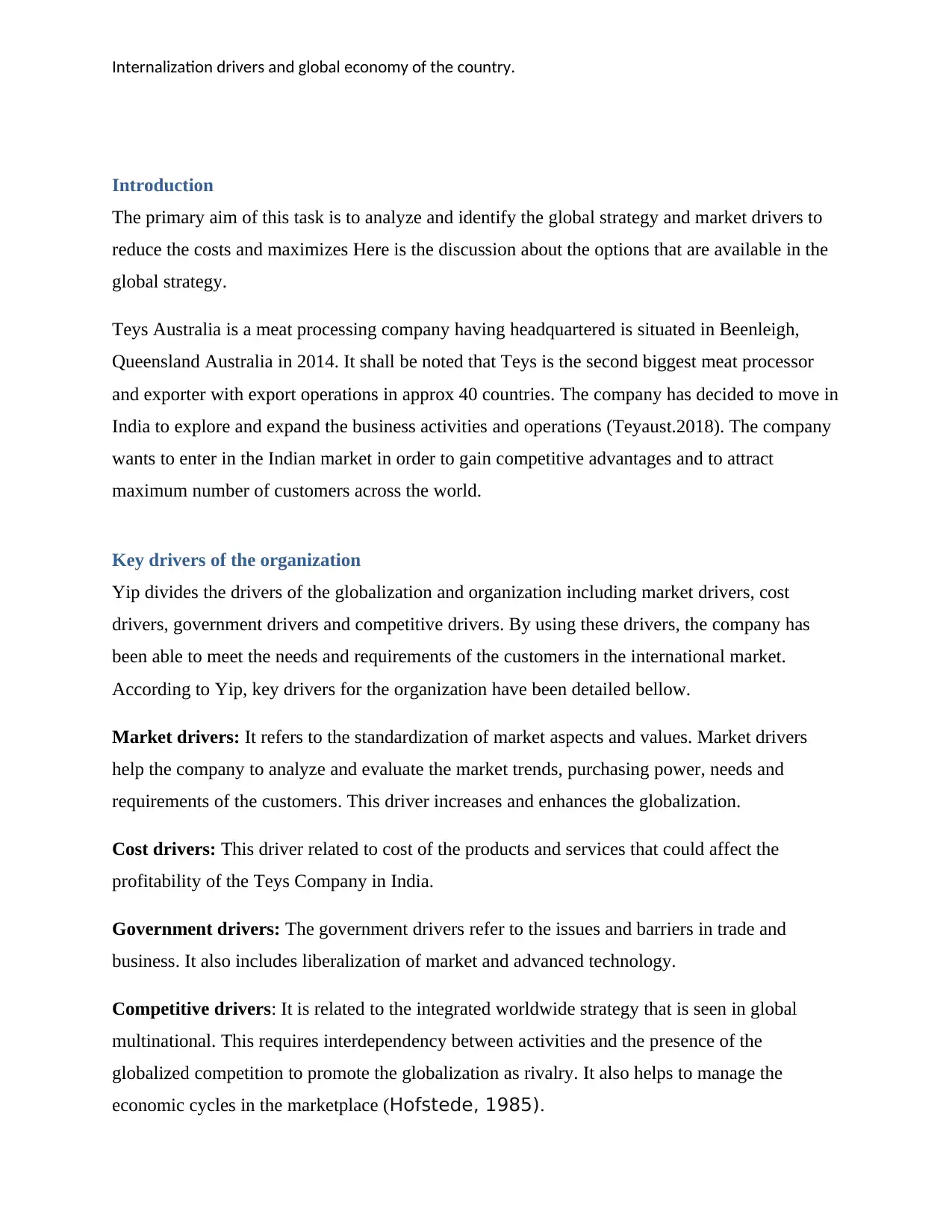
Internalization drivers and global economy of the country.
Introduction
The primary aim of this task is to analyze and identify the global strategy and market drivers to
reduce the costs and maximizes Here is the discussion about the options that are available in the
global strategy.
Teys Australia is a meat processing company having headquartered is situated in Beenleigh,
Queensland Australia in 2014. It shall be noted that Teys is the second biggest meat processor
and exporter with export operations in approx 40 countries. The company has decided to move in
India to explore and expand the business activities and operations (Teyaust.2018). The company
wants to enter in the Indian market in order to gain competitive advantages and to attract
maximum number of customers across the world.
Key drivers of the organization
Yip divides the drivers of the globalization and organization including market drivers, cost
drivers, government drivers and competitive drivers. By using these drivers, the company has
been able to meet the needs and requirements of the customers in the international market.
According to Yip, key drivers for the organization have been detailed bellow.
Market drivers: It refers to the standardization of market aspects and values. Market drivers
help the company to analyze and evaluate the market trends, purchasing power, needs and
requirements of the customers. This driver increases and enhances the globalization.
Cost drivers: This driver related to cost of the products and services that could affect the
profitability of the Teys Company in India.
Government drivers: The government drivers refer to the issues and barriers in trade and
business. It also includes liberalization of market and advanced technology.
Competitive drivers: It is related to the integrated worldwide strategy that is seen in global
multinational. This requires interdependency between activities and the presence of the
globalized competition to promote the globalization as rivalry. It also helps to manage the
economic cycles in the marketplace (Hofstede, 1985).
Introduction
The primary aim of this task is to analyze and identify the global strategy and market drivers to
reduce the costs and maximizes Here is the discussion about the options that are available in the
global strategy.
Teys Australia is a meat processing company having headquartered is situated in Beenleigh,
Queensland Australia in 2014. It shall be noted that Teys is the second biggest meat processor
and exporter with export operations in approx 40 countries. The company has decided to move in
India to explore and expand the business activities and operations (Teyaust.2018). The company
wants to enter in the Indian market in order to gain competitive advantages and to attract
maximum number of customers across the world.
Key drivers of the organization
Yip divides the drivers of the globalization and organization including market drivers, cost
drivers, government drivers and competitive drivers. By using these drivers, the company has
been able to meet the needs and requirements of the customers in the international market.
According to Yip, key drivers for the organization have been detailed bellow.
Market drivers: It refers to the standardization of market aspects and values. Market drivers
help the company to analyze and evaluate the market trends, purchasing power, needs and
requirements of the customers. This driver increases and enhances the globalization.
Cost drivers: This driver related to cost of the products and services that could affect the
profitability of the Teys Company in India.
Government drivers: The government drivers refer to the issues and barriers in trade and
business. It also includes liberalization of market and advanced technology.
Competitive drivers: It is related to the integrated worldwide strategy that is seen in global
multinational. This requires interdependency between activities and the presence of the
globalized competition to promote the globalization as rivalry. It also helps to manage the
economic cycles in the marketplace (Hofstede, 1985).
⊘ This is a preview!⊘
Do you want full access?
Subscribe today to unlock all pages.

Trusted by 1+ million students worldwide
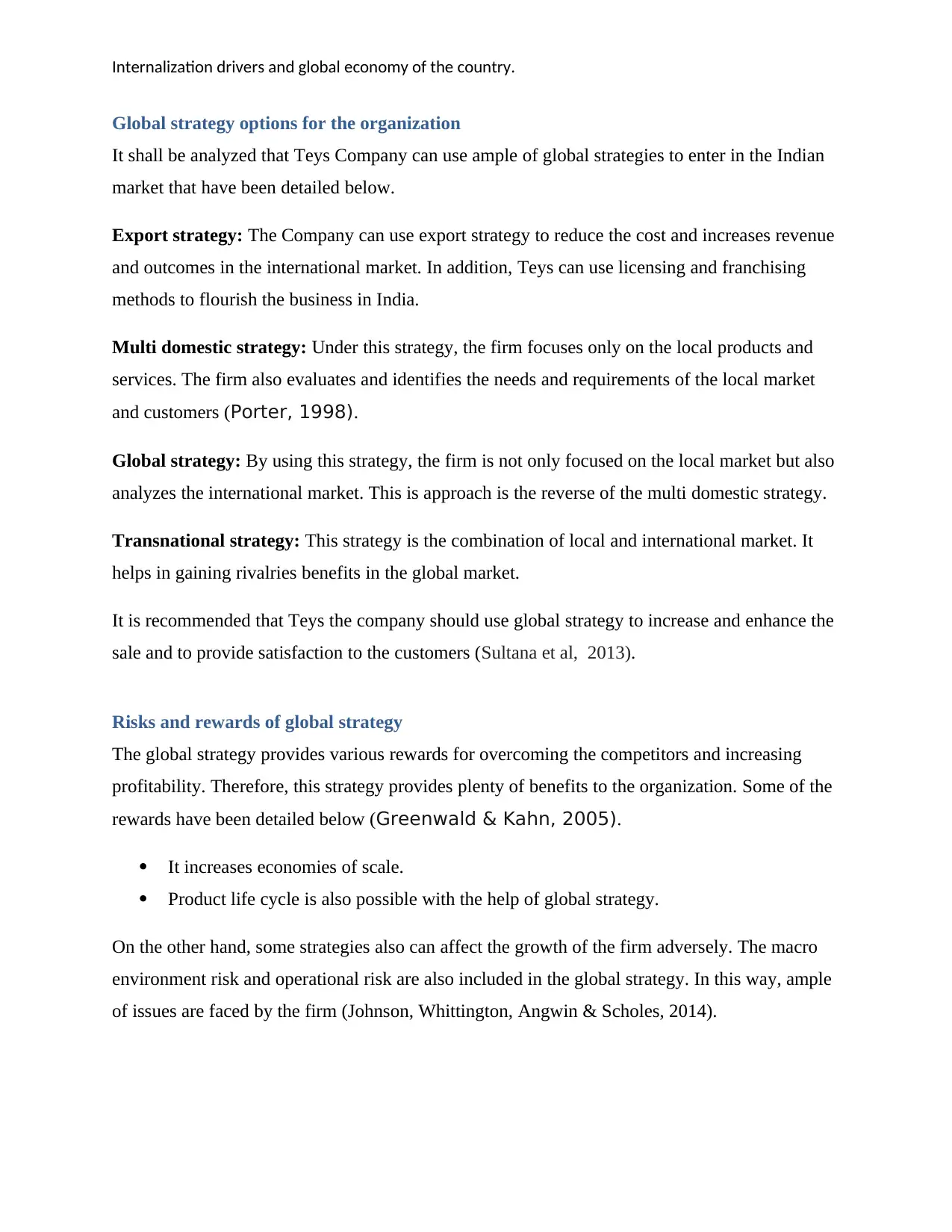
Internalization drivers and global economy of the country.
Global strategy options for the organization
It shall be analyzed that Teys Company can use ample of global strategies to enter in the Indian
market that have been detailed below.
Export strategy: The Company can use export strategy to reduce the cost and increases revenue
and outcomes in the international market. In addition, Teys can use licensing and franchising
methods to flourish the business in India.
Multi domestic strategy: Under this strategy, the firm focuses only on the local products and
services. The firm also evaluates and identifies the needs and requirements of the local market
and customers (Porter, 1998).
Global strategy: By using this strategy, the firm is not only focused on the local market but also
analyzes the international market. This is approach is the reverse of the multi domestic strategy.
Transnational strategy: This strategy is the combination of local and international market. It
helps in gaining rivalries benefits in the global market.
It is recommended that Teys the company should use global strategy to increase and enhance the
sale and to provide satisfaction to the customers (Sultana et al, 2013).
Risks and rewards of global strategy
The global strategy provides various rewards for overcoming the competitors and increasing
profitability. Therefore, this strategy provides plenty of benefits to the organization. Some of the
rewards have been detailed below (Greenwald & Kahn, 2005).
It increases economies of scale.
Product life cycle is also possible with the help of global strategy.
On the other hand, some strategies also can affect the growth of the firm adversely. The macro
environment risk and operational risk are also included in the global strategy. In this way, ample
of issues are faced by the firm (Johnson, Whittington, Angwin & Scholes, 2014).
Global strategy options for the organization
It shall be analyzed that Teys Company can use ample of global strategies to enter in the Indian
market that have been detailed below.
Export strategy: The Company can use export strategy to reduce the cost and increases revenue
and outcomes in the international market. In addition, Teys can use licensing and franchising
methods to flourish the business in India.
Multi domestic strategy: Under this strategy, the firm focuses only on the local products and
services. The firm also evaluates and identifies the needs and requirements of the local market
and customers (Porter, 1998).
Global strategy: By using this strategy, the firm is not only focused on the local market but also
analyzes the international market. This is approach is the reverse of the multi domestic strategy.
Transnational strategy: This strategy is the combination of local and international market. It
helps in gaining rivalries benefits in the global market.
It is recommended that Teys the company should use global strategy to increase and enhance the
sale and to provide satisfaction to the customers (Sultana et al, 2013).
Risks and rewards of global strategy
The global strategy provides various rewards for overcoming the competitors and increasing
profitability. Therefore, this strategy provides plenty of benefits to the organization. Some of the
rewards have been detailed below (Greenwald & Kahn, 2005).
It increases economies of scale.
Product life cycle is also possible with the help of global strategy.
On the other hand, some strategies also can affect the growth of the firm adversely. The macro
environment risk and operational risk are also included in the global strategy. In this way, ample
of issues are faced by the firm (Johnson, Whittington, Angwin & Scholes, 2014).
Paraphrase This Document
Need a fresh take? Get an instant paraphrase of this document with our AI Paraphraser

Internalization drivers and global economy of the country.
Conclusion
The above mentioned analysis shows that company uses global strategy and whether how the
firm is using key drivers while initiating the business success and growth of the firm.
Conclusion
The above mentioned analysis shows that company uses global strategy and whether how the
firm is using key drivers while initiating the business success and growth of the firm.
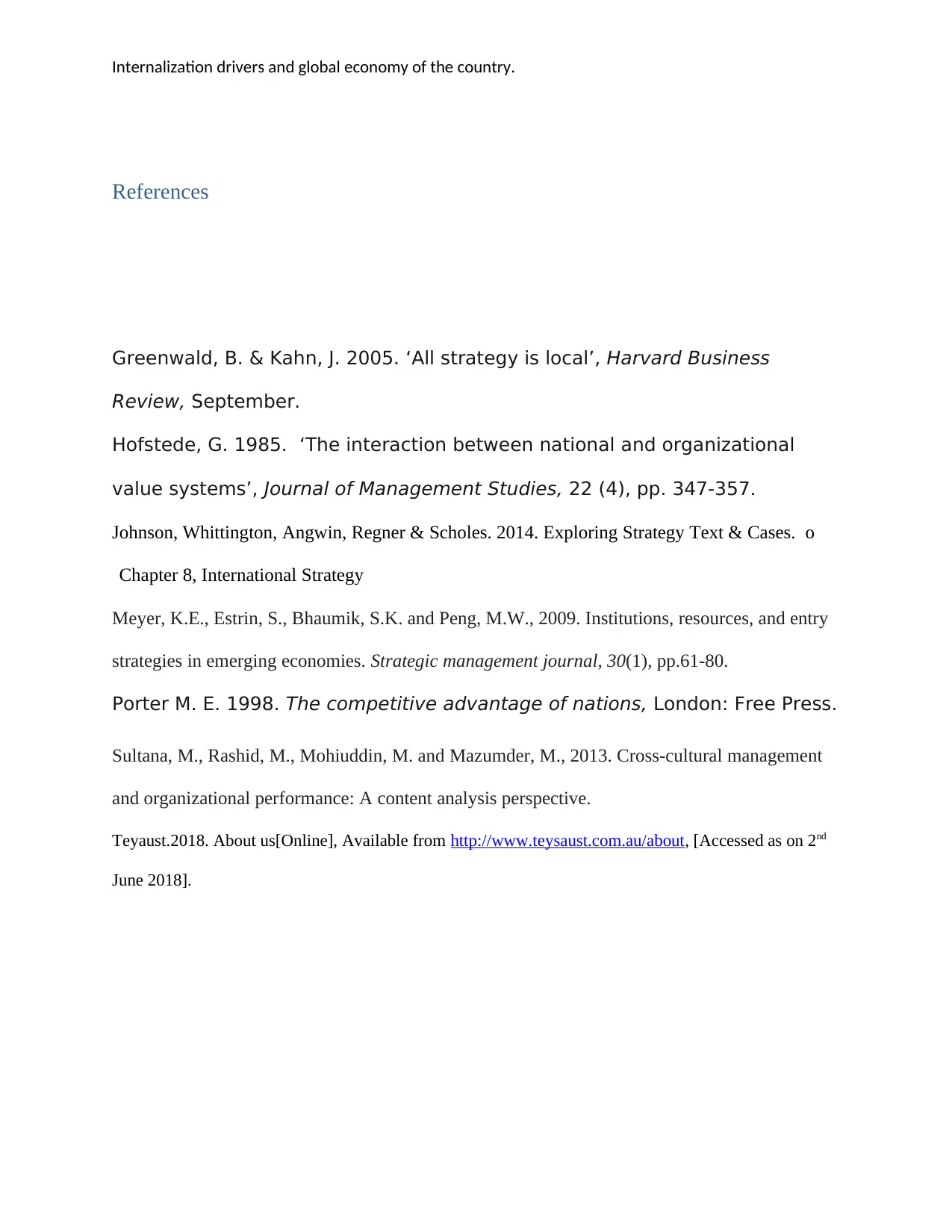
Internalization drivers and global economy of the country.
References
Greenwald, B. & Kahn, J. 2005. ‘All strategy is local’, Harvard Business
Review, September.
Hofstede, G. 1985. ‘The interaction between national and organizational
value systems’, Journal of Management Studies, 22 (4), pp. 347-357.
Johnson, Whittington, Angwin, Regner & Scholes. 2014. Exploring Strategy Text & Cases. o
Chapter 8, International Strategy
Meyer, K.E., Estrin, S., Bhaumik, S.K. and Peng, M.W., 2009. Institutions, resources, and entry
strategies in emerging economies. Strategic management journal, 30(1), pp.61-80.
Porter M. E. 1998. The competitive advantage of nations, London: Free Press.
Sultana, M., Rashid, M., Mohiuddin, M. and Mazumder, M., 2013. Cross-cultural management
and organizational performance: A content analysis perspective.
Teyaust.2018. About us[Online], Available from http://www.teysaust.com.au/about, [Accessed as on 2nd
June 2018].
References
Greenwald, B. & Kahn, J. 2005. ‘All strategy is local’, Harvard Business
Review, September.
Hofstede, G. 1985. ‘The interaction between national and organizational
value systems’, Journal of Management Studies, 22 (4), pp. 347-357.
Johnson, Whittington, Angwin, Regner & Scholes. 2014. Exploring Strategy Text & Cases. o
Chapter 8, International Strategy
Meyer, K.E., Estrin, S., Bhaumik, S.K. and Peng, M.W., 2009. Institutions, resources, and entry
strategies in emerging economies. Strategic management journal, 30(1), pp.61-80.
Porter M. E. 1998. The competitive advantage of nations, London: Free Press.
Sultana, M., Rashid, M., Mohiuddin, M. and Mazumder, M., 2013. Cross-cultural management
and organizational performance: A content analysis perspective.
Teyaust.2018. About us[Online], Available from http://www.teysaust.com.au/about, [Accessed as on 2nd
June 2018].
⊘ This is a preview!⊘
Do you want full access?
Subscribe today to unlock all pages.

Trusted by 1+ million students worldwide
1 out of 6
Related Documents
Your All-in-One AI-Powered Toolkit for Academic Success.
+13062052269
info@desklib.com
Available 24*7 on WhatsApp / Email
![[object Object]](/_next/static/media/star-bottom.7253800d.svg)
Unlock your academic potential
Copyright © 2020–2025 A2Z Services. All Rights Reserved. Developed and managed by ZUCOL.





